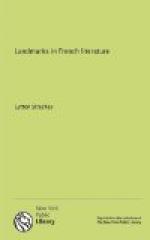so Ronsard addresses his mistress; and the image is a charming one of quiet and refined old age, with its half-smiling memories of vanished loves. What had become, in the hands of Villon, a subject for grim jests and horrible descriptions, gave to Ronsard simply an opportunity for the delicate pathos of regret. Then again the note changes, and the pure, tense passion of Louise Labe—
Oh! si j’etais en ce
beau sein ravie
De celui-la pour lequel vais
mourant—
falls upon our ears. And then, in the great sonnet sequence of Du Bellay—Les Antiquites de Rome—we hear a splendid sound unknown before in French poetry—the sonorous boom of proud and pompous verse.
Contemporary with the poetry of the Pleiade, the influence of the Renaissance spirit upon French literature appeared with even more striking force in the prose of RABELAIS. The great achievement of the Pleiade had been the establishment, once and for all, of the doctrine that literature was something essentially artistic; it was Rabelais who showed that it possessed another quality—that it was a mighty instrument of thought. The intellectual effort of the Middle Ages had very rarely clothed itself in an artistic literary form. Men laughed or wept in the poetry or prose of their own tongue; but they thought in scholastic Latin. The work of Jean de Meung was an exception; but, even there, the poetical form was rough and feeble; the artistic and the intellectual principles had not coalesced. The union was accomplished by Rabelais. Far outstripping Jean de Meung in the comprehensiveness and vigour of his thought, he at the same time infinitely surpassed him as an artist. At first sight, indeed, his great book hardly conveys such an impression; to a careless reader it might appear to be simply the work of a buffoon or a madman. But such a conception of it would be totally mistaken. The more closely one examines it, the more forcibly one must be struck alike by its immense powers of intellect and its consummate literary ability. The whole vast spirit of the Renaissance is gathered within its pages: the tremendous vitality, the enormous erudition, the dazzling optimism, the courage, the inventiveness, the humanity, of that extraordinary age. And these qualities are conveyed to us, not by some mere conscientious pedant, or some clumsy enthusiast, but by a born writer—a man whose whole being was fixed and concentrated in an astonishing command of words. It is in the multitude of his words that the fertility of Rabelais’ spirit most obviously shows itself. His book is an orgy of words; they pour out helter-skelter, wildly, into swirling sentences and huge catalogues that, in serried columns, overflow the page. Not quite wildly, though; for, amid all the rush and bluster, there is a powerful underlying art. The rhythms of this extraordinary prose are long and complex, but they exist; and they are controlled with the absolute skill of a master.




